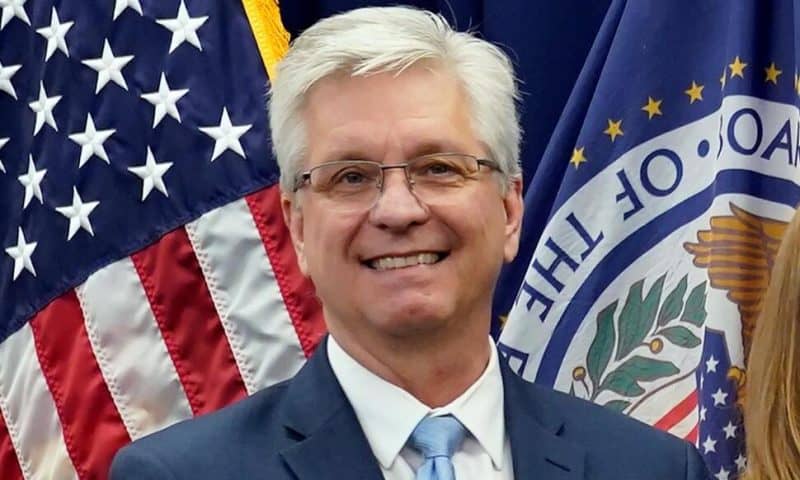A key Federal Reserve official raised the possibility that the Fed could decide to cut its benchmark interest rate as early as spring if inflation keeps declining steadily
WASHINGTON — A key Federal Reserve official raised the possibility Tuesday that the Fed could decide to cut its benchmark interest rate as early as spring if inflation keeps declining steadily.
The official, Christopher Waller, a member of the Fed’s Board of Governors, cautioned that inflation is still too high and that it’s not yet certain if a recent slowdown in price increases can be sustained. But he sounded the most optimistic notes of any Fed official since the central bank launched its aggressive streak of rate hikes in March 2022, and he signaled that the central bank is likely done raising rates.
Waller is regarded as a relatively “hawkish” official, meaning that he typically favors higher rates to combat inflation rather than low rates to boost job growth. But he has also become somewhat of a bellwether for the Fed’s overall rate-setting committee.
If inflation continues to cool “for several more months — I don’t know how long that might be — three months, four months, five months — that we feel confident that inflation is really down and on its way, you could then start lowering the policy rate just because inflation is lower,” Waller said in remarks at the American Enterprise Institute, a Washington, D.C.-based think tank. “It has nothing to do with trying to save the economy or recession.”
Fed officials have previously suggested that eventually, cooling inflation would lead the Fed to cut rates. That’s because, adjusted for inflation, the central bank’s benchmark rate effectively rises as inflation falls.
And because the Fed’s key rate affects rates on consumer and business loans, like mortgages and credit cards, it becomes more of a drag on the economy. That’s why as inflation slows, the Fed could reduce its benchmark rate just to keep its inflation-adjusted level stationary.
Still, Waller’s remarks were a more explicit suggestion that such a scenario could occur as early as spring. Waller also said he thought the Fed’s short-term rate, which is at 5.4%, the highest in 22 years, is likely high enough to keep inflation headed down to the central bank’s 2% target.
“I am increasingly confident,” he said, that the Fed’s interest rate policies are “currently well-positioned to slow the economy and get inflation back to 2%,” Waller said.
Waller’s remarks Tuesday suggested that the Fed’s outlook for interest rates may have decisively shifted in the past few months. In September, the Fed’s policymakers had signaled that they expected to raise their key short-term rate once more this year. At their most recent meeting, which ended Nov. 1, they kept the rate unchanged. Now, with signs that inflation is cooling, the officials are considered virtually certain to keep rates steady again at their final meeting of the year, Dec. 12-13.
Waller’s remarks follow Chair Jerome Powell’s more cautious comments earlier this month, when Powell said “we are not confident” that the Fed’s key short-term interest rate was high enough to fully defeat inflation. The Fed has raised its rate 11 times in the past year and a half.
Inflation, measured year over year, has plunged from a peak of 9.1% in June 2022 to 3.2% in October. Waller said October’s inflation report, which showed prices were flat from September to October, “was what I want to see.”
In a speech in October, Waller noted that inflation had cooled rapidly even as the economy continued to grow at a healthy pace. “Something’s got to give,” he said, meaning that either the economy would have to slow or inflation might re-accelerate.
“I am encouraged by what we have learned in the past few weeks — something appears to be giving, and it’s the pace of the economy,” he said Tuesday.
Still, Waller cautioned that, given the uncertainties surrounding the outlook for the economy, “I cannot say for sure whether” the Fed has done enough to conquer inflation.
Skanda Amarnath, executive director at Employ America, an advocacy group, and a former Fed economist, said the Fed will be particularly attentive to inflation data at the beginning of 2024, because prices spiked in the first couple of months of the year in 2022 and 2023.
“If we get through the (first quarter) of this upcoming calendar year and inflation has not reared its head in quite the same ugly way we saw the previous few ones, I think the Fed will have a lot more confidence,” Amarnath said, which could “also mean the Fed is interested in possibly lowering interest rates.”
Waller noted that recent data on hiring, consumer spending, and business activity suggested that economic growth was cooling from its torrid 4.9% annual pace in the July-September quarter. Slower spending and hiring, he said, should help further cool inflation.
Last month’s figures “are consistent with the kind of moderating demand and easing price pressure that will help move inflation back to 2%, and I will be looking to see that confirmed in upcoming data releases,” Waller said.
Also Tuesday, another member of the Fed’s board, Michelle Bowman, who has long taken a more hawkish stance on inflation, said there were still too many uncertainties surrounding inflation and the economy to be sure that the Fed is done hiking rates.
“My baseline economic outlook continues to expect that we will need to increase (the Fed’s key) rate further,” Bowman said in a speech in Salt Lake City to the Utah Banker’s Association. “We should keep in mind the historical lessons and risks associated with prematurely declaring victory in the fight against inflation, including the risk that inflation may settle at a level above our 2% target.”

